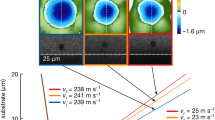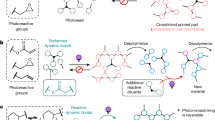Abstract
THE Young's modulus of carbon fibres based on a single commercial acrylic steadily increases with increasing process temperature1–3, and reaches 30×106 pounds/inch2 at a final processing temperature of 1,000° C. A corresponding relation for the breaking strength of the fibres shows a peak in strength at either 1,500° C (ref. 1) or 1,200° C (refs. 2 and 3), giving the high breaking strain (1.3 per cent) type of fibre, followed by a decrease in strength at higher processing temperatures. Tests of strength versus gauge length1,4 have shown that weak spots or flaws influence the breaking strength of the fibres, and this is illustrated, at least for the high strain type of fibres, by microscopy and fractography2,3,5. Any relationship between strength and modulus, which has a positive slope, seems to be limited to the processing temperature range 500°–1,000° C. In this temperature range particularly, mechanical properties of the fibres are influenced by the processing conditions and by the nature of the starting material. Any material or processing condition which allows fusion or gross disruption of the pyrolysing polymer will lead to incoherent carbon fibre with poor mechanical properties.
This is a preview of subscription content, access via your institution
Access options
Subscribe to this journal
Receive 51 print issues and online access
$199.00 per year
only $3.90 per issue
Buy this article
- Purchase on Springer Link
- Instant access to full article PDF
Prices may be subject to local taxes which are calculated during checkout
Similar content being viewed by others
References
Moreton, R., Watt, W., and Johnson, W., Nature, 213, 690 (1967).
Johnson, J. W., ACS Polymer Preprints, 9, 1316 (1968).
Johnson, J. W., J. Appl. Polymer Symp. (9), 229 (1969).
Moreton, R., Fibre Sci. Tech., 1, 273 (1969).
Johnson, J. W., and Thorne, D. J., Carbon, 7, 659 (1969).
Sanders, R. E., Chem. Process Eng., 49, 100 (1968).
Thorne, D. J., J. Appl. Polymer Sci., 14, 103 (1970).
Author information
Authors and Affiliations
Rights and permissions
About this article
Cite this article
THORNE, D. Strength–Modulus Relation for Carbonized Acrylic Fibres. Nature 225, 1039–1040 (1970). https://doi.org/10.1038/2251039a0
Received:
Issue Date:
DOI: https://doi.org/10.1038/2251039a0
This article is cited by
-
Problem of study of durability properties of carbon fibers based on polyacrylonitrile fibers by ultrasonic methods
Polymer Mechanics (1979)
-
Carbon fibres with large breaking strain
Nature (1974)
-
The effect of fibre diameter on the mechanical properties of graphite fibres manufactured from polyacrylonitrile and rayon
Journal of Materials Science (1971)
-
The effect of fibre diameter on the mechanical properties of graphite fibres manufactured from polyacrylonitrile and rayon
Journal of Materials Science (1971)
Comments
By submitting a comment you agree to abide by our Terms and Community Guidelines. If you find something abusive or that does not comply with our terms or guidelines please flag it as inappropriate.



